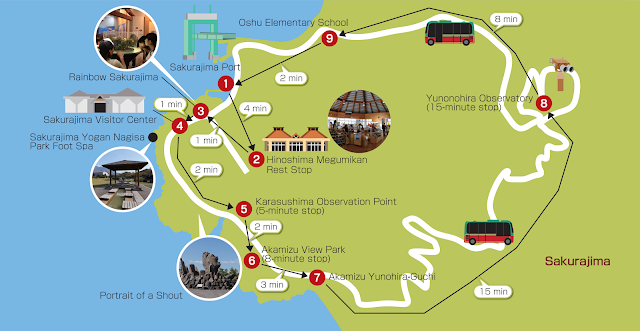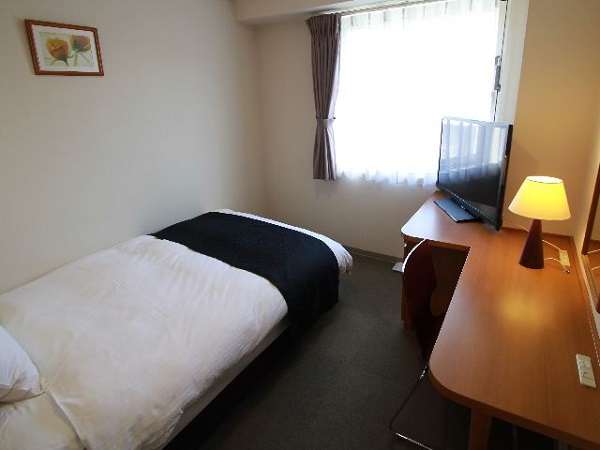Floating just 4km away from Kagoshima City is Sakurajima (桜島), one of the most
active volcanoes in the world. It is the symbol of Kagoshima and can be viewed prominently at many places around the city. Home to 7000 people (yes people do actually live on the island), Sakurajima is also best known for growing the world's largest daikon radish and the world's smallest Mandarin orange!
Visiting an active volcano might seem like a crazy idea to most people but Sakurajima was the exact reason that brought us (and many others) to Kagoshima. The volcano produces hundreds of small explosions each year, and there's a good chance that you will see smoke spewing out from the mountain when you visit. Thankfully, there was no signs of volcanic activity on the day we visited and we had a very pleasant experience touring around the island.
Getting to Sakurajima from our hotel was really easy. We had earlier purchased the 2-Day Welcome Cute Card (1500 yen) from the tourist office at Kagoshima Chuo Station, which allowed us to take unlimited rides on the city view buses, trams and ferry for two consecutive days. If you total up the cost for all the transport you are going to take over the course of two days, you will find that the pass pretty much pays itself off. It also saves you the trouble of rummaging through your purse for coins!
We boarded a tram (in the direction towards Tenmonkandori
and Kagoshima-ekimae) from the tram stop near the main entrance of the
Kagoshima-Chuo Station (on the map below, it is known as Kagoshima chuo eki-mae). Like other parts of Japan, you board the tram from the
rear and alight from the front. As we had the Welcome Cute card, we only needed to show the pass to the driver when we alighted.
We alighted at the Suizokukan-guchi tram stop after a 15 min ride through the city and followed the street signs / stickers on
the floor to the Kagoshima Port to take the ferry over to
Sakurajima. [This is the same stop to alight if you wish to visit to the Aquarium.]
There are numerous ferry connections to and from Sakurajima
throughout the day (frequency ranges from 15 to 30 mins depending on the time
of day), which makes the journey to the island super easy.
There was still some time before the next ferry arrived, so
we decided to break for lunch. There are only two very small eateries at the ferry terminal so we went for the safe bet: the ramen shop. To our astonishment, the tonkatsu shoyu ramen we ordered was super
oishii!
What made the meal extraordinarily unforgettable was the
couple who owned the shop. They were so incredibly warm and nice! When the obasan saw my husband sweating like mad after downing the hot bowl of soup, she brought
out a paper fan and STARTED TO FAN HIM while apologising profusely for the lack
of fans in the shop. Armed with my scant knowledge of the Japanese language
gleaned from watching a few anime series, all I could muster embarrassingly was
"daijobu! daijobu!"
The ice was also broken when we discovered that the couple
could speak some English and we had a jolly conversation about our respective
countries, the weather, food that our countries were famous for, our holiday
plans etc. To end the meal, the wife also gave us two yakults on the house!
Super impressed and bowled over by their hospitality!
Price of ramen: 750 yen. The experience: priceless!
Tummies filled, we hopped on the ferry for the short 15 minute
ride across Kinko Bay to Sakurajima. The ferry is not only for passengers only,
but it’s for cars too!
The view on the top deck was enthralling as the volcano
drew closer and closer as we reached the shore. Similar as the tram ride, we
did not have to pay for the ferry ride, and we only needed to flash
the Welcome Cute Pass when we disembarked from the ferry.
| Kagoshima Port |
| Sakurajima Port |
Once on solid ground, we queued up for the Sakurajima Island
View Bus, which is a hop on/off loop bus which traverses the major sights on the western side of Sakurajima. The fare for the bus is covered under the Welcome Cute Pass.
The bus stop is located one floor down from the ferry terminal and it is very easy
to locate.
There are many other ways to explore Sakurajiam such as rental
cars, sightseeing buses, regular buses, bicycles and even on foot if you’re
keen on hiking, but the loop bus was the most convenient, easiest and economical option
for us.
The timetable of the bus can be seen below:
At certain key stops along the bus route, we were allowed to alight from the bus for a couple of minutes to take photos. For instance, the bus stopped for 5 minutes at the Karasujima Observatory, 8 minutes at the Akamizu View Park and 15 minutes at the Yunohira Observatory.
You do have to be punctual and watch the clock closely otherwise you will be left behind! The bus leaves every stop on time and if you did not manage to board the bus, you will have to wait another hour for the next bus to come by!
For such a popular mode of transport, it is unfortunate that the frequency of the bus is pretty low (only one per hour)! If you miss the bus or weren’t able to board because of the crowd, you will have to wait for another bus that comes by one hour later. Very fortunately, the bus that we took (the 2.20pm bus) was relatively empty, save us and 5 other people and we managed to complete the entire loop without incident.
The timetable of the bus can be seen below:
| Sakurajima Island View Bus |
At certain key stops along the bus route, we were allowed to alight from the bus for a couple of minutes to take photos. For instance, the bus stopped for 5 minutes at the Karasujima Observatory, 8 minutes at the Akamizu View Park and 15 minutes at the Yunohira Observatory.
| Yunohira Observation Point |
You do have to be punctual and watch the clock closely otherwise you will be left behind! The bus leaves every stop on time and if you did not manage to board the bus, you will have to wait another hour for the next bus to come by!
For such a popular mode of transport, it is unfortunate that the frequency of the bus is pretty low (only one per hour)! If you miss the bus or weren’t able to board because of the crowd, you will have to wait for another bus that comes by one hour later. Very fortunately, the bus that we took (the 2.20pm bus) was relatively empty, save us and 5 other people and we managed to complete the entire loop without incident.
The entire loop bus journey lasted about an hour and when we returned back to the terminal, we alighted and re-boarded the bus again to go to the Sakurajima Visitor Center (first stop). This small visitor center has models, pictures, videos and information boards about Sakurajima and some of it is in English.
The main reason for stopping here, however, is for the Nagisa Park Foot Bath that is located near the visitor centre. This free foot bath stretches for several metres and you can simply pick a quiet spot, sit down and soak your tired feet while gazing across the sea to Kagoshima City.
 |
| Nagisa Park &Foot Spa - Photo Credit |
As evening descended, we took a stroll by the coast and then walked back to the ferry terminal to head back to the mainland.
All in all, this was a perfect start to our Kyushu holiday!








